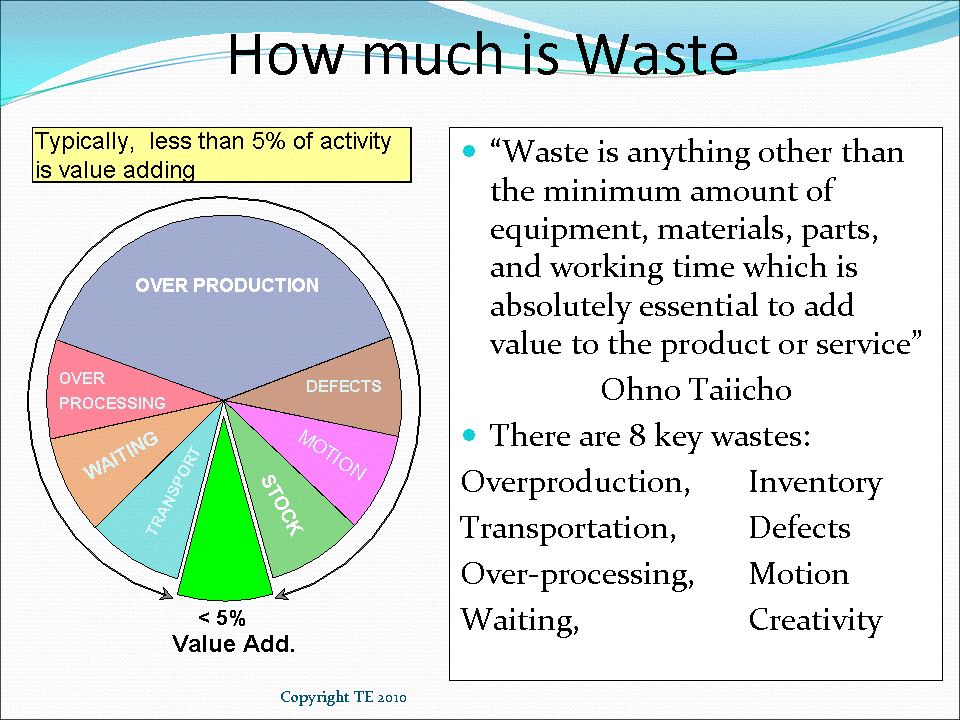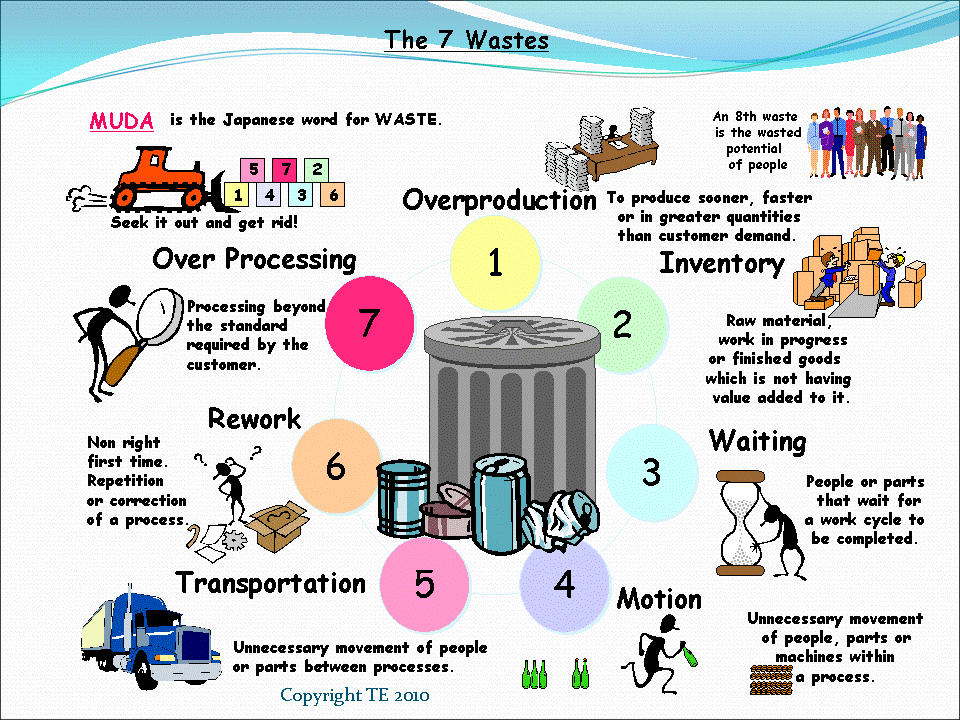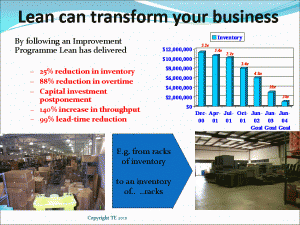Why Implement Lean Manufacturing?
If you are considering Implementing Lean Manufacturing or one of your Customers is insisting that you go down this road you are probably asking yourself “what’s in this for me?”
There are many companies that have implemented lean manufacturing and are singing its praises and claiming massive improvements and also companies that insist that they “have done lean” and gained nothing but problems from it! But what is the truth, what are the benefits of lean manufacturing?
Lean Manufacturing has originated from the Toyota Production System (TPS), unarguably the most successful automotive manufacturer. Toyota consistently outsells any other manufacturer and its products top polls and surveys with regards to quality and reliability. They are also a profitable company unlike so many of their rivals facing bankruptcy around the world!
If Toyota’s success is not enough reason; what are the actual benefits of Lean?
The Benefits of Implementing Lean Manufacturing
The implementation of lean manufacturing through trying to make value flow at the pull of the customer (Just In Time) prevents and eliminates waste in your processes. Waste being categorized as part of the seven wastes; Transport, Inventory, Motion, Waiting, Over-processing, Overproduction, and Defects.
All of these wastes have a direct impact on your costs, they are all non-value adding operations, operations that your customer would not be happy to pay for and add no value to the product or service that you provide.
Many studies have shown that we only add value for around 5% of the time within our operations, the remaining 95% is waste! Imagine if you could remove that 95% wasted time and effort; what would it do for your operations?
Lean Removes Waste
Typically Lean will improve;
- Quality performance, fewer defects and rework (in house and at customer).
- Fewer Machine and Process Breakdowns.
- Lower levels of Inventory.
- Greater levels of Stock Turnover.
- Less Space Required.
- Higher efficiencies, more output per man hour.
- Improved delivery performance.
- Faster Development.
- Greater Customer Satisfaction.
- Improved employee morale and involvement.
- Improved Supplier Relations.
- HIGHER PROFITS!
- INCREASED BUSINESS!
Are these not good enough reasons to implement Lean?
Gaining Satisfied Customers
The first principle of Lean is identifying value as perceived by the customer; if you can provide your customer what they want every time then you will ensure that you have satisfied customers. If you always supply top quality products and services on time, at the right place then you have a business that is going to succeed! Implementing Lean provides you with those satisfied customers that are going to keep on returning to buy from you allowing you to maintain and even grow your business.
Financial impact of Lean
While many accountants see lots of stock as a benefit to the business and an asset it really is a major hindrance to your business. Stock costs money to store and to move and it uses your cash (or you have to borrow) to maintain it. One of the major aims of Lean is to eliminate the stock in your processes, we seek to eliminate inventory that is generally there to hide all of the other problems. This in turn releases cash back into your hands to use within the business (Remember; Cash is King!)
Removing inventory also frees up space and removes the need for excessive amounts of handling equipment as well as removing the opportunity for handling damage and even for products becoming obsolete.
An example of this is a company that I visited in the UK, they wanted a 30k loan from the government to buy some machinery. This company employed about 100 people and turned over over 2million GB pounds. But they held over 2 million pounds of stock in their warehouse and half of their employees were employed only in moving product around. The products were simple and the company could actually manufacture them quicker than they could find them and retrieve them from the stores. This company could free up over 2 million just be starting to make to order and using up all of their stock.
Lean Improves Your Profits
Most companies work on the following formula;
Selling price = Profit + Costs
But if your selling price is too high you customers will not buy from you, the selling price is in reality something that is fixed by the market and not by you. If you don’t offer your product or service at the right selling price you will not retain or gain customers.
You should work on the following;
Profit = Selling price – Costs
Lean works to drive down your costs; therefore the more you save the higher your profits. Every penny that you save is added directly to your profit. Companies that implement Lean typically make significant cost savings that have a very real impact on the companies profitability. As mentioned earlier you only have to look at the performance of Toyota against the big US car makers to see the difference.
Lean Manufacturing Implementation Facts and Figures
The following information is taken from the Manufacturing Advisory Service in the UK, they have been performing business improvement projects in many thousands of manufacturing companies across the Uk for the last several years. Most of these projects are based on the principles and tools of Lean manufacturing.
The following figures are average results for companies in many differing industries and of different sizes over a period of several years;
- DELIVERY +26%
- STOCK TURNS +33%
- PRODUCTIVITY +25%
- SCRAP -26%
- SPACE -33%
These are average figures from thousands of projects, not just a select few studies to make the figures look good. These figures are typical of what other academic and consultancy studies have published.
What would an increase in productivity of 25% mean to your company? How much time and money would be saved if scrap levels were reduced by 26%. How many angry customers would be happy and how many panic transports avoided if your delivery performance improved by 26%? How much cash would be freed up if you could reduce your inventory? What could you do with a third of your space free?
Risks of Implementing Lean
Lean is not a one size fits all, implement by the book overnight tool! It requires commitment and the involvement of everyone within your organization.
It is often very easy to work around the principles of lean to hit short term targets at the end of each month to look good, this often undermines lean initiatives leading to its rapid dismissal as an effective tool.
Gains made by individual applications of tools are often lost over a short period of time due to there being no overall focus on a lean culture for the business.
People see that improvements to efficiency can make their jobs unnecessary so they resist the changes unless there are policies in place to redeploy them in a productive manner.
The Need to change
As Deming once said; “It is not necessary to change, survival is not mandatory!” You can stay as you are and hope that no one out there makes better cheaper products that better meet you customers needs…
However we are now in a global market, someone out there is looking at your share of the market and working out how to win it from you, will you just sit back and give it to them? Your competitors will improve, they will evolve, they may even revolutionize your industry, you need to be there first or you will lose your business.
It is not enough to just make improvements when a crisis hits, you need to have a program of continual business improvement to ensure that your business will thrive, not just struggle to survive.
Implementing Lean Manufacturing and Lean Tools are a proven method to improve your business and beat the competition.





Good
Great article on outlining the different terminology in lean manufacturing and six sigma. I enjoyed the read. 🙂